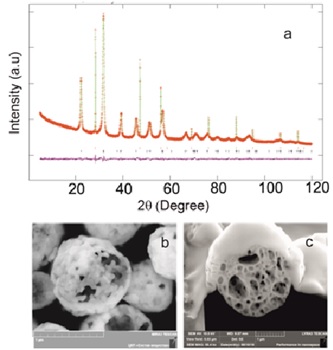NANOSYSTEMS: PHYSICS, CHEMISTRY, MATHEMATICS, 2020, 11 (5), P. 565–571
Spin-glass transition in porous spheres BiFeO3
A.V. Dmitriev – Institute of Solid State Chemistry, UB RAS, 91, Pervomaiskaya Str., Ekaterinburg, 620990, Russia; dmitriev@ihim.uran.ru
E.V. Vladimirova – Institute of Solid State Chemistry, UB RAS, 91, Pervomaiskaya Str., Ekaterinburg, 620990, Russia
M. A. Semkin – Ural Federal University, Department of Magnetism, 48, Kuibyshev Str., Ekaterinburg, Russia
A.V. Korolev – M. N. Mikheev Institute of Metal Physics UB RAS, 18, S. Kovalevskaya Str., Ekaterinburg, 620108, Russia
Magnetic properties of porous spheres BiFeO3 have been studied at temperatures ranging from 2 to 300 K. A transition to cluster spin glass state has been detected in the region of about 100 K. The presence of the transition is confirmed by nonlinear variation of coercive force and the appearance of exchange displacement of magnetic hysteresis loops at temperature below 100 K. Temperature dependence of magnetization for zero-field cooled regime exhibit a maximum at some temperature Tm. The function Tm(H) (H is magneic field) changes in accordance with Almeida–Thouless line. The performed measurements of the frequency dependence of AC susceptibility confirm the behavior of spin glass with spin freezing temperature Tf = 116 K. The critical index zν = 2.5 agrees well with the mean-field theory zν = 2.0.
Keywords: bismuth ferrite, magnetic properties, porous spheres, Almeida–Thouless line, spin cluster glass.
DOI 10.17586/2220-8054-2020-11-5-565-571
